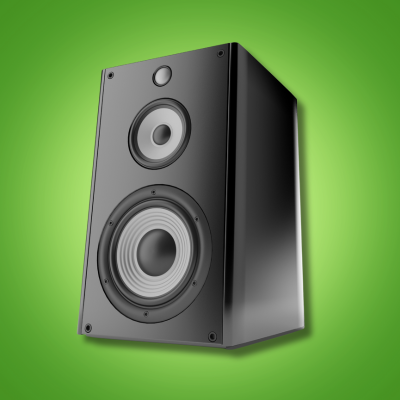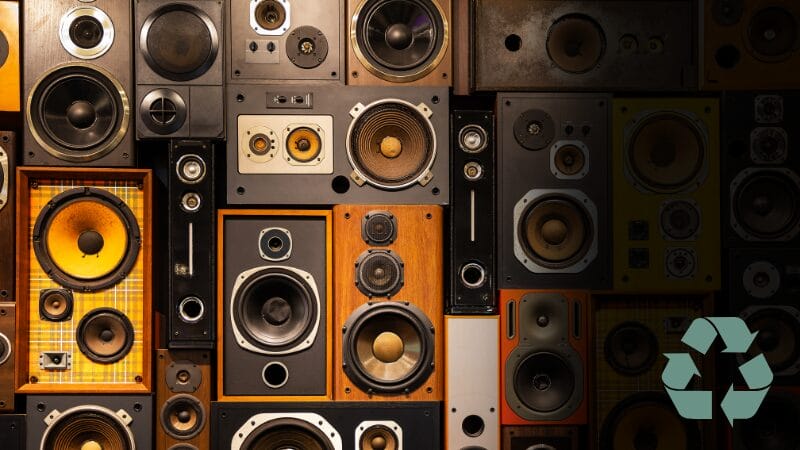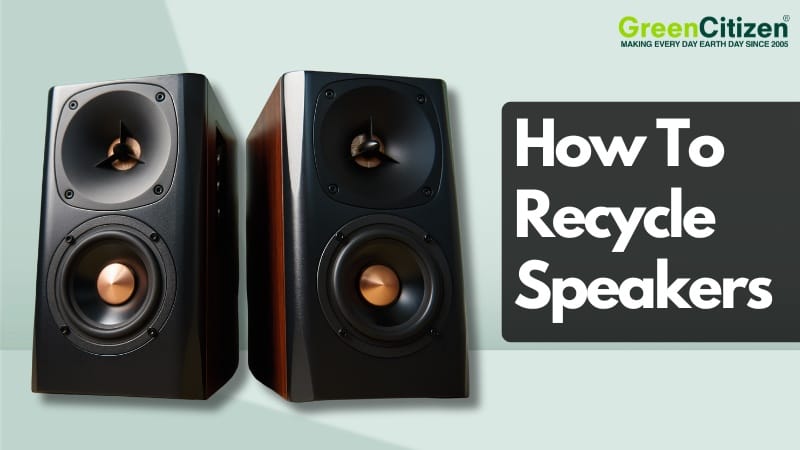Most people don’t think twice before tossing out an old speaker. But every Bluetooth or smart speaker you’ve ever owned — from a worn-out JBL to a retired Sonos Connect — hides valuable materials inside.
Magnets, copper wire, and durable plastic casings can all be recycled instead of ending up in landfills.
So, how do you recycle speakers?
You can bring them to a certified electronics recycling center, where technicians safely separate reusable parts like neodymium magnets, copper coils, and plastic enclosures for material recovery. It’s simple, safe, and keeps hazardous metals out of the environment.
Speakers may seem small, but when millions pile up in storage closets or dumpsters, the waste adds up fast. Learning how to recycle speakers properly not only conserves resources — it also keeps your old audio gear in circulation as raw material for new products.
💡 Key Takeaway: Can You Recycle Speakers and How To Do It Right
Yes — speakers are recyclable. The best option is to bring them to a certified electronics recycling facility that can safely process magnets, metals, and plastics, but repairing or reusing them first can help extend their lifespan. To find nearby recyclers that handle speakers properly, search the Green Directory for verified drop-off locations.

Best Speaker Recycling Service in the Bay Area
Stay Compliant with California E-Waste Laws — Recycle Your Speakers the Right Way With GreenCitizen.
Can Speakers Be Recycled?
Yes — most speakers can be recycled. Inside every speaker are recyclable materials like copper wiring, neodymium or ferrite magnets, aluminum frames, and plastic enclosures that can be recovered and reused.
The trick is separating these materials safely, since adhesives, mixed plastics, and small circuit boards make manual processing necessary.
When you drop off an old speaker at a recycling center, technicians disassemble the unit into its key components — magnets, metal parts, copper coils, and plastic shells. Each of these parts enters a different recycling stream: copper is refined and reused in wiring, magnets are reclaimed for new audio equipment, and plastics are melted down for manufacturing other products.
Even compact Bluetooth speakers and smart models like Sonos or Google Home follow the same process. Though they often contain more electronics and lithium batteries, they can still be dismantled for material recovery instead of ending up in landfills.
What Parts of a Speaker Can Be Recycled?
Most speakers contain several recyclable components — from magnets and metal frames to copper wiring and plastic housings.
When properly processed, nearly 80–90% of a speaker’s materials can be recovered and reused in new manufacturing.
Speaker Magnets
Every speaker relies on a magnet assembly, typically made from neodymium or ferrite. These rare-earth and ceramic magnets can be separated, cleaned, and remanufactured into new audio equipment or small motors.
Neodymium magnets are especially valuable due to their high magnetic strength and demand in green technologies like EV motors and wind turbines.
Metal Frames and Driver Components
The frame or basket that holds the speaker cone is often made of steel or aluminum, both of which are highly recyclable. These metals can be melted down and reused without loss of quality.
Inside the driver, small amounts of iron, nickel, and aluminum are also recovered during recycling — contributing to circular material flow in the electronics industry.
Copper Voice Coils and Speaker Wires
Speakers use copper wire in their voice coils — the coiled wire that moves the diaphragm to produce sound. This copper is stripped, refined, and reused in new electrical applications.
External speaker wires also contain copper cores covered in insulation; recyclers process them mechanically to recover the copper without burning the plastic.
Plastic Enclosures and Grilles
The outer housing and grille are usually made from ABS or polypropylene plastic. These plastics are shredded, cleaned, and pelletized for reuse in non-electronic products such as casings, automotive parts, or construction materials.
Some high-end speaker models use blended materials or adhesives, which can complicate recycling — but professional e-waste facilities are equipped to separate these effectively.
Circuit Boards and Electronic Components
Smart or powered speakers often include a printed circuit board (PCB) containing small quantities of gold, silver, and palladium.
Specialized recyclers extract these metals through controlled chemical or mechanical processes, ensuring that even trace materials are recovered safely.
✅ Summary: What parts of a speaker can be recycled?
Magnets, copper wires, metal frames, plastics, and circuit boards can all be recycled. These materials are separated at electronic recycling centers for reuse in new manufacturing.

How To Get Rid of Old or Broken Speakers
You should never throw old or broken speakers in the trash. Most contain recyclable metals, magnets, and electronic parts that can be recovered safely — and some may even be reusable if they still function.
The right way to get rid of speakers depends on their condition and type: whether they still work, are repairable, or have reached end of life.
Recycle Through Certified E-Waste Centers
If your speakers no longer work, the most responsible option is to bring them to a certified electronics recycling facility — not just any drop-off point.
Certified recyclers follow strict environmental and worker-safety standards to make sure all materials are handled properly, from magnet separation to circuit-board processing.
Certified facilities (look for certifications like R2v3 or e-Stewards) are independently audited to verify they manage hazardous materials safely, track all e-waste to its final destination, and never export electronics illegally to developing countries.
Choosing a certified recycler ensures that your old speakers won’t end up in overseas landfills or informal recycling operations where components are burned or dumped.
When dropping off devices, ask if the recycler can provide a certificate of recycling or proof of responsible processing. This level of transparency distinguishes certified operations from non-certified or informal collectors, who may simply resell or scrap items without proper handling.
Even small desktop or wireless speakers can be processed safely. Facilities that meet certification standards have equipment for mixed materials, adhesives, and built-in batteries — all common in today’s compact speaker designs.
Repair or Repurpose Functional Units
If the issue is minor — such as a torn cone, broken wire, or loose connection — speakers can often be repaired or repurposed. Many hobbyists convert old speaker drivers into DIY sound projects, subwoofer enclosures, or home workshop sound systems.
Repairing instead of discarding not only saves money but also extends the product’s usable life — one of the simplest forms of sustainability.
Avoid Landfills or Curbside Disposal
Tossing speakers into household trash can send heavy metals, plastics, and adhesives into landfills — materials that take decades to break down. Many cities enforce e-waste disposal bans, meaning speakers must be recycled through approved facilities.
Always check local recycling regulations before disposal to ensure compliance and avoid fines.
Benefits of Recycling Speakers
As audio manufacturers work toward greener production, more speakers are now made from recycled or responsibly sourced plastics. These designs reduce the need for virgin materials and show how electronics recycling directly feeds into sustainable manufacturing.
How Recycled Plastic Is Used in Speakers
Most speaker enclosures are made from ABS (Acrylonitrile Butadiene Styrene) or polypropylene, both of which can be recovered from old electronics and reprocessed into durable new casings. Recycled plastic pellets are cleaned, melted, and molded into speaker housings, stands, and even internal mounting parts.
Some companies have also begun using post-consumer recycled (PCR) plastics or ocean-bound plastics, diverting waste that would otherwise pollute waterways. These materials maintain strength and acoustic performance while reducing CO₂ emissions associated with virgin plastic production.
The Circular Connection Between Recycling and Design
When consumers recycle old speakers, those materials — particularly plastics, aluminum frames, and magnets — re-enter the supply chain. This “circular” design loop ensures that end-of-life products become feedstock for new manufacturing instead of landfill waste.
For example, plastic recovered from discarded electronics can be turned into new audio equipment, office products, or even automotive parts. Each reuse cycle extends the lifespan of the original material and helps close the loop between consumption and sustainability.
Why Sustainable Materials Matter
Plastic production accounts for nearly 4% of global greenhouse gas emissions, and electronics contribute significantly to that footprint. Using recycled materials can reduce embodied carbon by up to 60%, while also decreasing landfill volume and demand for fossil-based feedstocks.
For consumers, choosing speakers made with recycled materials — or recycling old ones responsibly — directly supports this shift toward circular electronics.
✅ What Is A Recycled Plastic Speaker?
A recycled plastic speaker is made using reclaimed ABS or polypropylene from old electronics. These materials are cleaned, remolded, and reused to reduce waste and carbon emissions while maintaining durability and sound quality.
Where To Recycle Speakers Near Me
If you have old or broken speakers, the best place to take them is a local electronics recycling center that handles small e-waste devices. These facilities have the tools to safely dismantle speakers, separate recyclable materials, and process plastics, metals, and magnets for reuse.
Always confirm whether the recycler accepts speakers specifically — smaller centers may focus on computers or batteries only.
Best Electronics Recycling Option for the San Francisco Bay Area
For residents and businesses in the San Francisco Bay Area, GreenCitizen provides a trusted, one-stop recycling solution for speakers and other electronics.
Our Burlingame Eco-Center accepts walk-in drop-offs for personal devices, while our Business Pickup Program covers offices, schools, and community organizations throughout the region.
Every item processed through GreenCitizen is handled locally and responsibly — ensuring full material recovery and keeping e-waste out of overseas landfills.
Whether you’re recycling one old desktop speaker or clearing out an entire office audio system, GreenCitizen makes it simple to do it responsibly and sustainably.

Best Speaker Recycling Service in the Bay Area
Stay Compliant with California E-Waste Laws — Recycle Your Speakers the Right Way With GreenCitizen.
FAQ: Common Questions About Speaker Recycling
Yes. Most speakers contain recyclable materials like magnets, copper wire, metal frames, and plastic housings. Bring them to a certified electronics recycler to ensure the components are safely dismantled and reused instead of ending up in landfills.
Even smart or wireless speakers can be recycled. Remove any detachable cables, then drop them off at a certified e-waste facility. These centers safely process mixed materials and batteries found in Bluetooth or Wi-Fi-enabled speakers.
Yes. Speakers are recyclable because they contain metals, plastics, and magnets that can be separated and reused. Recycling keeps valuable materials in circulation and prevents electronic waste from contaminating soil and water.
Yes. Speaker wire is made of copper surrounded by plastic insulation. Recyclers strip or mechanically process the insulation to recover the copper, one of the most valuable and easily recyclable metals.
Recycle them through a certified e-waste center or see if they can be repaired. Avoid throwing broken speakers in the trash — they contain materials that should be properly processed or reused.
You can use the Green Directory by GreenCitizen to find verified recycling centers near your ZIP code. It lists certified facilities that accept speakers and other electronics. You can also check local municipal or state e-waste directories.
Magnets, copper coils, metal frames, and plastic enclosures are all recyclable. Some models also contain small circuit boards with trace metals that specialized recyclers can recover.
Conclusion: Turning Old Speakers Into New Resources
Every speaker, no matter how outdated or broken, still holds value in the materials inside it. By recycling them responsibly, you help recover metals, plastics, and magnets that can live a second life in new products — instead of contributing to landfill waste.
Speaker recycling isn’t just about clearing clutter; it’s part of a bigger cycle of resource conservation. Whether you drop off your old devices at GreenCitizen, search the Green Directory for certified facilities, or participate in a local e-waste event, every action contributes to a cleaner, more sustainable future.
It’s a small step for one household — but multiplied across thousands, it becomes a powerful force for change.
